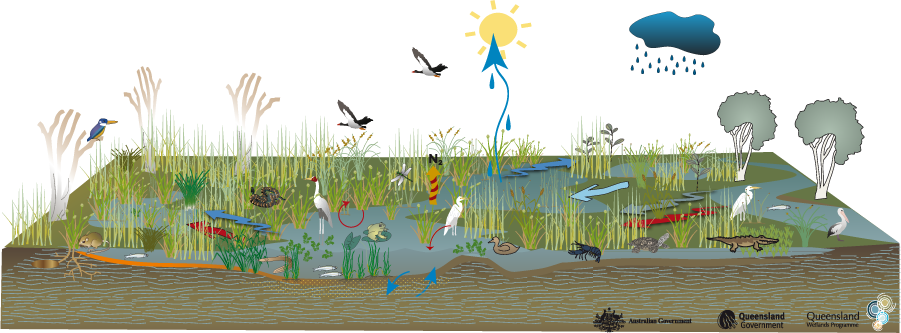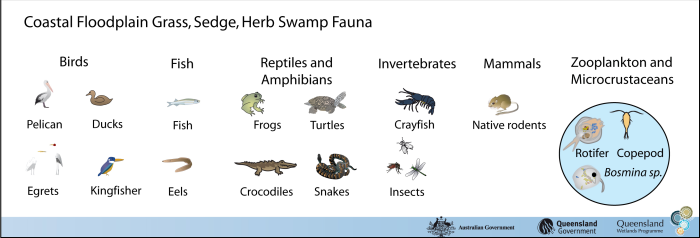|
|
Coastal and subcoastal floodplain grass, sedge, herb swampCoastal and subcoastal floodplain grass, sedge, herb swamp – FaunaClick on elements of the model or select from the tabs below Birds
Birds, such as cranes, ducks, black winged stilts, egrets, pelicans and magpie geese, can all be found in this wetland habitat type, as can kingfishers (depending on the fish abundance). Birds are often the most conspicuous component of the fauna and can use these areas to rest, breed and feed. FishWhere there is connectivity to streams and/or the sea, fish may occur in season. Though fish diversity tends to be low, coastal grass, sedge, herb swamp habitats can be important nursery and feeding ground for barramundi and other fish species even if just for short periods of time. The depth of the waterbody is also a very important determinant for its usefulness as a fish habitat—deeper waters tend to have higher dissolved oxygen levels and provide more favourable habitats for fish for longer periods. Eels can also be found in coastal floodplain grass, sedge and herb swamps, such as Eagers Swamp on Moreton Island which drains to the ocean by Eagers Creek and can have considerable populations of eels. Reptiles and AmphibiansFrogs, crocodiles and turtles can be abundant. Reptiles that inhabit freshwater wetland habitats include the Red-bellied Black Snake (Pseudchis porphyriacus), Arafura File Snake (Acrochordus arafurae), which is largely aquatic, and the Freshwater Snake (Keelback Tropidonophis mairii). InvertebratesDuring inundation, invertebrates can drive the food web, and larger animals, such as freshwater crayfish and crabs, may occur. MammalsRodents and other small mammals can exploit the dense cover and seasonal availability of food (e.g. seed and bulkuru (Eleocharis spp.) tubers). InsectsA range of insects can be found in this wetland habitat type, including dragonflies, damselflies, mosquitoes and sandflies. Zooplankton and MicrocrustaceansZooplankton and microcrustaceans—microscopic aquatic fauna that graze on phytoplankton and detritus—can also be present. Last updated: 22 March 2013 This page should be cited as: Department of Environment, Science and Innovation, Queensland (2013) Coastal and subcoastal floodplain grass, sedge, herb swamp – Fauna, WetlandInfo website, accessed 8 May 2025. Available at: https://wetlandinfo.des.qld.gov.au/wetlands/ecology/aquatic-ecosystems-natural/palustrine/floodplain-grass-sedge-herb-swamp/fauna.html |

 — Department of the Environment, Tourism, Science and Innovation
— Department of the Environment, Tourism, Science and Innovation




